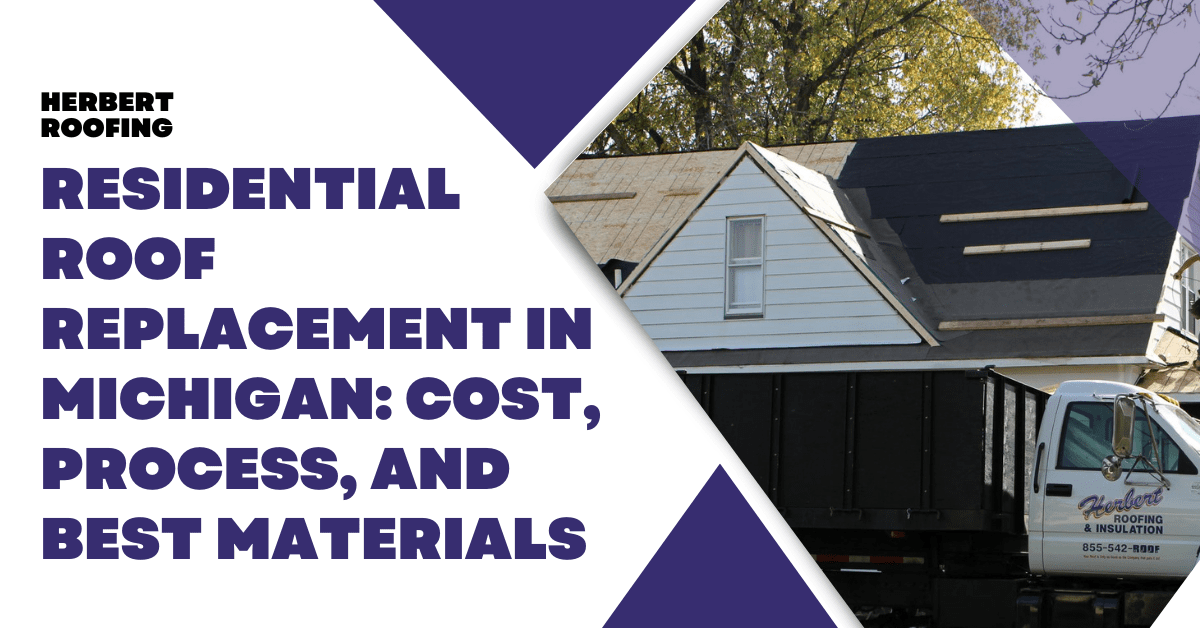Key Takeaways
- Recognizing when to replace your roof is crucial: in Michigan’s climate, many asphalt roofs reach the end of their lifespan around 20–30 years. This Old House
- Choosing the right materials and certified contractors’ matters. Using premium brands like GAF or CertainTeed and working with a roofing specialist ensures better warranties and job quality.
- Budgeting & financing are part of the process — an average asphalt shingle roof replacement can cost around $15,000, and many roofing companies offer financing options. GAF
- Inspection, preparation, installation, and follow-up are distinct phases; each deserves attention to get the best result for your home.
- Local conditions in Michigan — like freeze-thaw cycles, ice dams, and snow loads affect the process and material choices, so you need a roofer familiar with regional specifics.
When you live in Michigan, whether in Saginaw, Midland, Bay City, Traverse City, or Harbor Springs, the roof over your home takes a beating. From heavy snowfall and ice dams in winter to spring storms and summer sun, your roof system is working year-round. If you’re asking yourself, “Is it time for a roof replacement?” or “What’s involved in replacing a roof in a Michigan home?”, you’re in the right place.
In this guide, we’ll walk you through the entire process of a roof replacement: what to look for, how to choose materials (especially asphalt shingles from GAF, CertainTeed, etc.), how to select a local roofing company, what the budget and financing options look like, and how to maintain the results.
What is a Roof Replacement?
Roof Replacement
The process of removing an existing roof system (or necessary components) and installing a new roof system, including the deck, underlayment, flashing, ventilation, and final shingles (or other top-layer material).
Contrast with a roof repair, which addresses localized damage without replacing large portions of the system.
Why this matters: A complete roof replacement gives you a fresh start with new warranties and better longevity; a repair is often a stopgap.
Why Replace Your Roof? (Especially in Michigan)
Why now?
- Age and Lifespan: Most asphalt shingle roofs last about 20–30 years in average conditions. In Michigan’s harsher climate (cold winters, ice, snow), you might lean toward the shorter end of that spectrum.
- Visible Signs of Wear: According to manufacturers like GAF, signs like curling, missing shingles, granules in gutters, sagging, or light in the attic all point toward replacement rather than repair. GAF
- Protecting your Home: The roof is your home’s first line of defense against the weather. A failing roof leads to leaks, mold, and structural issues. Waiting too long can cost far more in damage than the replacement itself would cost.
- Added Home Value: A new roof pays off in curb appeal and resale value. One source estimates that a roof replacement added an average of $17,807 to resale value in 2023. GAF
- Warranties & Financing Opportunities: New roof systems often come with better warranties (especially when installed by certified contractors), and roof financing options are available. GAF
Pro Tip:
In Michigan, if your asphalt shingle roof is over 20 years old, has received little maintenance, or shows many signs of wear, start budgeting for a full replacement now rather than waiting until an emergency.
How to Prepare for Roof Replacement: Step-by-Step
Here’s the high-level flow for roof replacement. Each step will be broken down in depth below.
- Roof inspection & measurement
- Choosing materials and a contractor
- Budgeting & financing
- Scheduling and pre-installation preparation
- Installation day
- Post-installation inspection & warranty registration
- Maintenance plan
Roof Inspection & Measurement
Question: How do I know what condition my roof is in and what size it will be?
When you’re replacing a roof, the first step is to schedule a full roof inspection with a professional roofer (local to Michigan). During the inspection, they will look for:
- Missing, curled, or cracked shingles
- Granules in gutters
- Sagging roof deck or visible daylight in the attic
- Curling ridge caps or exposed underlayment
- Flashing problems around chimneys, vents, and valleys
- Ice-dam history or signs of moisture in the attic
According to roofing manufacturer GAF, these signs suggest replacement over mere repair. GAF




0 Comments